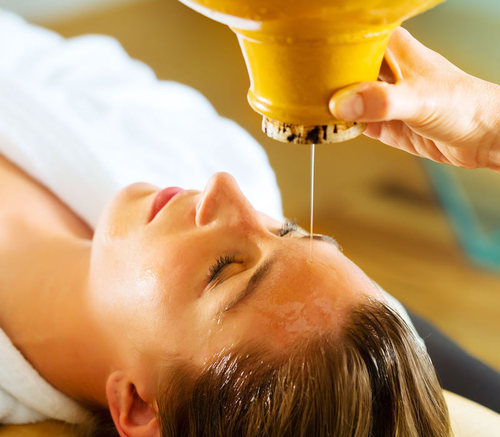A migraine headache is characterised as one of the most common primary disorder, where a person experiences a throbbing sensation in the head on the unilateral side. It is a complex Neurological Disorder. Getting rid of it permanently can be difficult with conventional medicines. Traditional therapies for Migraine are often associated with side effects, due to which patients are hesitant to take these medications and prefer complementary and alternative medicines like Ayurveda.
Triggers of Migraine-
There is no specific cause and cure for Migraine. Migraine pain can be triggered due to psychological stress, sleep deprivation, lack of physical exercise, fasting, and change in weather conditions. The frequency of migraine headaches vary between individuals, and the symptoms may include nausea, vomiting, sensitivity to light and visual disturbances. Weak digestion increases Ama in the body and prevents proper blood flow in the body and to the brain.
“World Health Organization has grades migraine as 6th among disability causing diseases”.
Ayurvedic Approach
Ayurveda and Yoga therapy are two ancient forms of medicine whose integration offers a comprehensive approach.
Migraine treatment in Ayurveda is known as Ardhavabhedaka–The treatment involves removal of Kapha Dosha, which in turn helps to prevent the Pitta disorders. This is achieved through the administration of samshodhana (Panchakarma-Bio-purificatory techniques, kaya virechana (therapeutic purgation), Pathya ahara (wholesome regulated diet) and Vihara (healthy regulated lifestyle). All of this help to maintain a balance between all doshas.
Migraine Treatment in Ayurveda
‘Nasya karma” is indicated to uproot the deep-seated diseases of the head.
Nasal Drops are known to be successful and are capable of breaking the Samprapti (Pathogenesis) of a Migraine. The drugs used are indicated for Urdhvajatrugata Vikara in classics. Amalaki due to its Sheetal [Cool] Potency lowers the aggravated Pitta. Yastimadhu removes excessive Kapha. Sunthi pacifies Vata and Kapha. Aritha is Urdhva shodhana in classics and can clear the blocked channels (Strotoshodhana). Management of Urdhvajatrugata Rogas (Diseases of the supraclavicular region), has a special place in Ayurveda.
Managing Migraine
Ayurveda can bring a balance in life and treat the root cause of Migraine. Let’s see how-
*Proper Food Habits— Depending on the dosha (s) involved in the headache and the patient’s constitution, the patient must eat a diet that pacifies the aggravated dosha. Also, minimise or avoid Migraine triggering foods
* Following a Healthy lifestyle—Maintain a regular sleep pattern, reduce stress, exercise regularly, maintain proper eating habits and avoid migraine triggers, to reduce the frequency of migraine headaches.
*Yoga
Yoga can help in preventing migraine headaches. It can also help with tension in the muscles of the neck, back, and head, which can contribute to problems. Yoga helps relax the muscles and the mind.
* Massage Therapy
Massage and stretching exercises can also help minimise the severity and frequency of migraine headaches.
*Meditation—Reciting mantras and practising meditation can calm your mind and reduce stress.
* Herbal oils—A mixture of essential oils can help to ease headaches. Peppermint oils and balm can help in Migraine.
* Aromatherapy—Essential oils can enter the body through the skin, nasal passages, bronchioles, lungs and gastrointestinal tract.
* Pranayama —Different breathing exercises have different effects on the body, mind and spirit. Breathing practices purify the Nadis. If the headache is due to Vata, one can benefit from alternate nostril breathing (Anuloma Viloma). If the trouble is due to Pitta, doing lunar and shitali pranayama can help. If Kapha dosha is the problem, then kapalabhati pranayama can be beneficial.
* Nose drops (Nasya)— About five drops of Brahmi ghee in each nostril can alleviate the pain of migraine headache.
Nasya in Migraine:
“Nasya treatment in Ayurveda” refers to the installation of Herbal oils or juice through the nasal route. It works well in disorders of the ear, nose, head, and throat. Nasya is one among the Panchakarma therapy in Ayurveda.
Handling migraine pain can never be manageable. Home remedies for Migraine can help you cure naturally without visiting a doctor or a pharmacy.
It is said that the administration of ginger tea can help reduce or stop uneasiness of Migraine pain and relieve the symptoms. Other remedies may include applying a hot or cold pack to ease the pressure on the scalp.
Temporary suppressing migraine pain with conventional medicines provides only short-term relief, and the pain can recur anytime.
Ayurveda understands the root cause of the problem and provides a treatment that can heal you from inside. Ayurveda restores the Ojas, by removing harmful toxins from the body and strengthens the nerves through proper blood circulation.
Many of these integrative therapies are useful but should be administered with the advice of the expert or Ayurveda Physician. So, let’s connect with “The Madras Institute of Ayurveda”, Chennai. This Institute offers Authentic Ayurvedic treatment from common to rare conditions. Log on to www.miayurveda.org to learn more.


